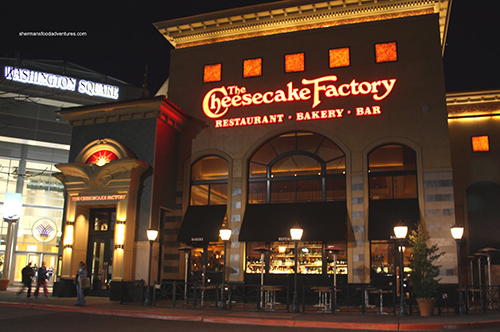This morning, my wife was driving me to work (because we now live in Texas and only have one car, and while I could take the bus it’s a little bit of a hassle — maybe when it gets a bit colder again) and when we got near downtown Fort Worth, we saw that an unique restaurant — something called Ferre — was being renovated into a Cheesecake Factory. My first thought was, “Damn, that place will be slammed at 5:30pm on Fridays,” which is undoubtedly true — and while I thought that to myself, I’ll definitely not avoid it at that time, and rather fight through throngs of people to get a Fat Tire on tap, because that’s how I roll.
But I have long been interested in what restaurants do for cities. This goes a little to the sprawl vs. urbanism discussion, because when you get out to a mall/anchor store area (think Macy’s, Nordstrom’s, huge parking lots, a movie theater, etc.) you tend to know what you’re gonna get: a Cheesecake, a Ruby Tuesday’s, a Chili’s, a P.F. Chang’s, etc. You see this in the downtown of some cities as well, but typically the downtown / midtown / hipster areas also have a lot of original restaurant content that, ostensibly, will bring in locals and tourists alike.
Now there’s a new report called “The State Of The City Experience” from Sasaki that talks about some of these issues; the paper is also summarized at CityLab. Core takeaway: people in cities tend to like (a) good food, (b) rejuvenated waterfront districts and (c) historical architecture. On the food front, there’s this quote:
Going out to eat has been a huge driver of America’s urban renaissance, judging by the poll results. Like any café owner in Paris, today’s U.S. restaurateurs know full well the vaunted place of food in the spectrum of city life. The line-out-the-door bistro is the meeting place, the water cooler, the modern-day bazaar—maybe even the new congregational convening. Have you been to (fill in the blank)? It’s central to the urban conversation.
Maybe a little bit of a jump to compare the American and Parisian cuisine scenes (although what do I really know? I’ve never been to Paris), but otherwise this makes sense. You can make an argument that we should prioritize food less with how many people are poor and hungry, and there’s an amount of validity there. But the fact is, people need to eat, and the middle class and above do like to have experiences around eating in their hometown — and apparently, they base some of their travel decisions on what areas are renowned for food as well.
Get this, as well:
The Sasaki survey results reflect a similar appreciation of the local, in ingredients and entrepreneurship. Forty-six percent of those surveyed said they want their cities to invest in more community-focused events and attractions such as farmer’s markets, swap meets, and food trucks.
Agree with this wholeheartedly. Whenever I move to a new city or visit a city for a weekend and know there’s the possibility of cooking involved, I automatically hit the iPhone to see what farmers’ markets are around. I don’t even always trust that farmers’ markets have the freshest stuff — there are occasions where supermarkets might, if they’re near farming areas and/or a lot of hubs — but it’s almost always very good and cheaper than average.
Maybe the title of this article should have been “What does food mean to cities?” The answer there is also “a lot, apparently.” But if you think about it in a Hierarchy of Needs-type way, it makes perfect sense. We need to eat and we don’t always want to do that at home — and when traveling, we almost never want to do it in a hotel / our friend’s house — so food shapes a good deal of our experiences.
This has a lot of roll-up for urban planners and designers: basically, make it relatively easy for new restaurants to open in uptown/downtown/midtown areas, and create community events/farmers’ markets along those areas as well to encourage people out for the late afternoon/early evening drinks + appetizers period. Oh, and make things walkable. Millennials like that, and businesses need them to come in droves in order to build their talent strategy.

This opens up lots of interesting debates around restaurants in cities… It was really interesting and inspiring to read your post. I had never though of it this way since we only rarely eat in malls (or comparable alternatives around here) and I have not eaten in a chain food restaurant in years (since I lived in the states probably). I kind of miss it actually!… the feeling of “you know what you’ll get” even if you walk in a new place! Thanks for sharing these urban and food thoughts!